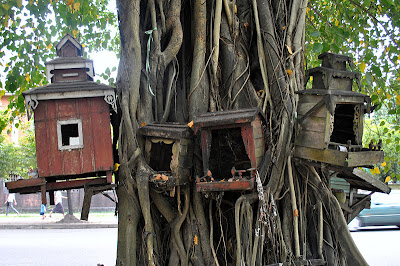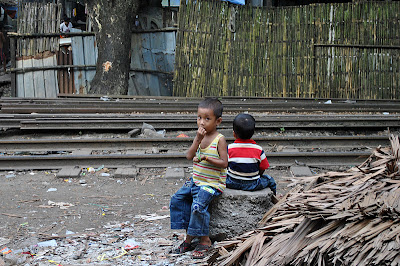Before traveling to Myanmar, or even before reading this blog (if you are really ambitious) we suggest the following reading list:
- "1984" by George Orwell (currently forbidden in Myanmar and a number of other communist countries)
- "Finding George Orwell in Burma" by Emma Larkin (short read that gives you a good overview of the past and present political and social climate in Burma)
- "Burmese Days" by George Orwell
The first notable thing about our trip to Myanmar was our flight. It was the most chaotic flight we’ve ever been on, and not because of the airline, but rather the passengers. On a typical flight when the plane is taxing but the seatbelt sign is on you will hear a few clicks as rebellious passengers try to jump the gun by unbuckling and gathering their things before the plane is fully stopped. On this flight however, there was practically a stampede the moment we touched down. Everyone unbuckled and jumped up, opened the overhead compartments and started pushing each other around in a rush to get of the plane. The man in front of us even made a break for the door... while we were still moving! The stewardess came out yelling for everyone to sit down, but it did little good. The chaos was somewhat explained soon however, as it seems that there were actually a lot of Burmese on the flight which is quite unusual as it is very hard for Burmese people to get passports or leave the country. At immigration there was a very long line for nationals, but only a couple foreigners and we actually got escorted through the “Diplomats” line, as it was empty. During the rest of our time in Myanmar we only met one local who had ever travelled outside of Myanmar.
 |
| The government-owned, english-language newspaper published by the Ministry of Information. The New Light of Myanmar is often viewed as propaganda on part of the Tatmadaw and the government, and features many articles about military officials. |
We had selected a hostel (Motherland Inn II) upon recommendation from Riki & Troy, and because it offered a free airport pickup, which was handy considering the airport was about 45 minutes outside of town. A friendly Burmese man wearing traditional longyi greeted us with a sign “Welcome to Mother Land Inn (2) Gerald Dewitt M +1”. We waited for the other few foreigners on our flight who had the same plan as us, then all got into a very “old-school” school bus and headed into town. In Myanmar, they drive on the right-hand side of the road, but only because the government made a switch to spite the British after independence. As a result (and compounded by the fact that it is very expensive, long process to obtain the permits to acquire a new vehicle in Myanmar) lot of vehicles still have steering wheels on the right. Myanmar became independent from British rule in 1948, and the military regime changed many names (Burma became Myanmar, for example), and many other things to try and abolish British influence all together. En route, we noticed that many houses, shops and apartments were fully decorated with Christmas lights, especially the tacky flashing kind. It was fairly late by the time we arrived at our hostel so we called it a night and tucked into our bed, which barely fit in our room.
The following morning we set out on a self-guided walking tour of the city. We should have started earlier in the day... by 11:00 it was almost unbearably hot. One thermometer we saw read 38 degrees Celsius. We wandered down Sule Paya Road to Sule Paya (2000 year old golden temple (“zedi”) which occupies the city center traffic circle). Seeking some shade we visited the Mahabandoola garden and the Independence Monument.
 |
| Burmese script on the Independence Monument. Even the numbers are in script, making it dificult for us to understand even the basics, and thus making it easy for vendors to trick us about prices! |
Street vendors selling anything and everything spilled onto the sidewalks, forcing us to walk on the road most of the time. Ancient wrought-iron hand cranks were used to pump out fresh cane juice for passersby and ladies waved plastic bags over sliced watermelon to keep the flies somewhat away. Spiced orange stands, old-school cane-juice pressing machines, and pirated DVD’s stalls were frequent, and we were happy to see that cats here had their full tails (according to a local, in Malaysia and Indonesia restaurant owners diligently crop or mutilate cat’s tails so they can’t jump up on open-air tables).
Nearly every street corner had a tea-shop: non-descript open-air concrete blocks with knee-height tables, tiny plastic stools and a bowl full of ceramic tea cups which you share with the customers before and after you (just rinse it out with a little tea if you are bothered). Endless weak Chinese tea is free, but you are expected to buy some cheap food or snacks to go with it. Traditionally, men go with other men, and women go with other women to tea shops. Mixed groups are uncommon, and in general there are far more men than women. They are busiest from 2:00 to 5:00 when it seems everyone goes to the tea shops to avoid the heat of the afternoon.
 |
| Buddhism is the major religion in Myanmar (an estimated 89% of the population is Buddhist) |
We tried to visit the central market but learned that it was closed for the day in celebration of some national holiday. We saw a banner saying it was “international white cane day” (?), but heard also that it was a once-yearly full moon celebration. Whatever the reason, it was an interesting day in the city. This also explained the Christmas lights. We were told later that locals traditionally put out hundreds of candles, but Christmas lights have somewhat taken over in recent years. There was also an excessive number of fireworks being set off all day long. We were told by one source that fireworks have only just been legalized in Myanmar so the locals go a little bit crazy with them. I wasn’t impressed with the frequency of the little explosions especially not when one exploded right next to me, leaving me very startled and with ringing ears for awhile. I think the young boy who set it off (while holding it) thought it was funny, but I did not.
 |
| A "trishaw" (cycle rickshaw) is a budget form of local taxi. Whenever you would pass one on the sidewalk they would call out to you in broken English "where you go?". |
After stopping for a cool drink at the local version of “Dunkin’ Donuts” (J' Donuts) we headed north towards the Shwedagon Paya (Pagoda). One refreshing thing about Myanmar is that you won't find any American chains here (McDonalds, 7-Eleven, etc...), unlike in the rest of South East Asia. Along the way I stopped to change into my “appropriate pagoda-going attire” (full length longyi, long-sleeved shirt). We stopped at a smaller pagoda along the way.
You have you remove your shoes while on the grounds and in the pagoda and women on the sidewalk outside will try to insist you bug a plastic bag to carry your shoes in (we had a backpack). We tiptoed through the pagoda full of praying locals, and didn’t spot a single other tourist.
There must have been something comical about the way I tied my sarong (or maybe it was because it was actually a silk sarong from Indonesia) because people kept looking at it and giggling and smiling. On the way out we stopped to buy another cold drink and I had the woman show me how to properly tie my longyi.
Because of the national holiday, Shwedagon was crawling with locals.
The locals and their picnics occupied every inch of every shady space on the grounds. We were disappointed to see that even in locations as worshiped as Shwedagon the locals still just toss their garbage on the ground, which made walking around barefoot a little less enjoyable. We would have stayed longer but the crowds were overwhelming and there was no where to seek shade amongst the throngs of people.
We caught a cab back to our hostel and retreated to the air-conditioned lobby (our room was a tiny stuffy sauna). After cooling off we headed to “Monsoon Restaurant” for dinner. Our “Lonely Planet on a Shoestring” ensured us that mains started around K2500 (~$3), which we figured was pretty reasonable for a higher end restaurant meal. Unfortunately when we got there we found the prices almost tripled. However, we were hungry and a long way from anywhere so we decided to just go for it and “splurge”. While the nearly $10 meal was more than our budget, we weren’t at all disappointed. I ordered Ayeyarwady butter fish curry with rice and Dewey had a beef curry with rice, both Myanmar specialities. Both were scrumptious. Getting skinless, boneless meat is a treat here!
On our second day in Yangon we explored the central Bogyoke Aung San Market, a 70-year old sprawling market with over 2000 shops selling everything and anything. You could socialize amongst locals at a teashop, get a suit tailored, buy precious gems, cheap replicas or handicrafts (including monkey-skull necklaces and pendants made from human (?!) bones), eat fried crickets or simple noodle soups, or attempt to pick a longyi from about a million available options (amongst other things).
 |
| Nat (spirits worshipped in Myanmar in conjunction with Buddhism) houses built into trees along the side of the streets. There are 37 nat spirits. |
 |
| Two boys sit outside of their hut. A small hut colony (slum) lined the railroad tracks just behind our guesthouse. |
 |
| Most of the housing in downtown Yangon was of this drab "soviet block" style |
That night we took a night bus to Mandalay. We learned that the always “reserve” the back of the bus (the worst seats... the ones that don’t recline) for tourists. From this point onwards we made a point of asking for any seats other than the back rows. Needless to say, not the best sleep.










No comments:
Post a Comment